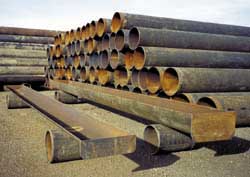
An Oklahoma company says steel pipe can be used to make heavy-duty, low-cost feed bunks at a much lower cost than conventional bunks.
"They work better than any other portable feed bunks we've seen because they're built so strong. Cattle can't tear them up," says Tyler Williams, CPI Pipe, Yukon, Okla.
The company buys and sells pipe by the ton. They use leftover natural gas pipe to make the bunks, cleaning the exterior first and then splitting them in half or thirds. They'll make the bunks for you, or you can make your own.
They start with 26-in. dia., 5/16-in. thick pipe and convert it into two different size bunks. When split in half, the 26-in. pipe spreads to 27 in. wide. The company welds each half onto a pair of 16-in. dia. heavy pipe legs that have saddles cut into them. The troughs average 23 ft. long and measure 13 in. deep, with the bunk's overall height at 26 in. Steel plates are welded onto both ends of the trough.
They also cut pipe into thirds, resulting in a bunk that's 22 in. wide and 6 in. deep, with an overall height of 20 in. Average bunk length is 23 ft.
"These are truly lifetime feed bunks, and everyone who sees them says we picked the right name for them. They offer more value than any other bunk on the market," says Williams. "Some farmers build their own 40-ft. long bunks. Smaller farmers like the smaller bunks because they can hook chains onto one of the legs and drag them anywhere. The bunks can also be ordered without end caps and used for fence line feeding. The bunks set inside one another on the ends, allowing you to make a continuous bunk line to any length.
"These bunks are cheaper, lighter, and easier to move than cement bunks. There are other commercial steel bunks, but they're generally made out of light 16-ga. sheet metal. Cows tend to move them around and tear them up. As a result, you have to continuously replace them every few years. Our 27-in. wide, 23-ft. long bunk weighs 1,243 lbs. You could put 5,000 lbs. into the middle part of the bunk without bending it."
